| |
|
Saturday, May 17 Tifereth Israel Synagogue—Dizengoff Night
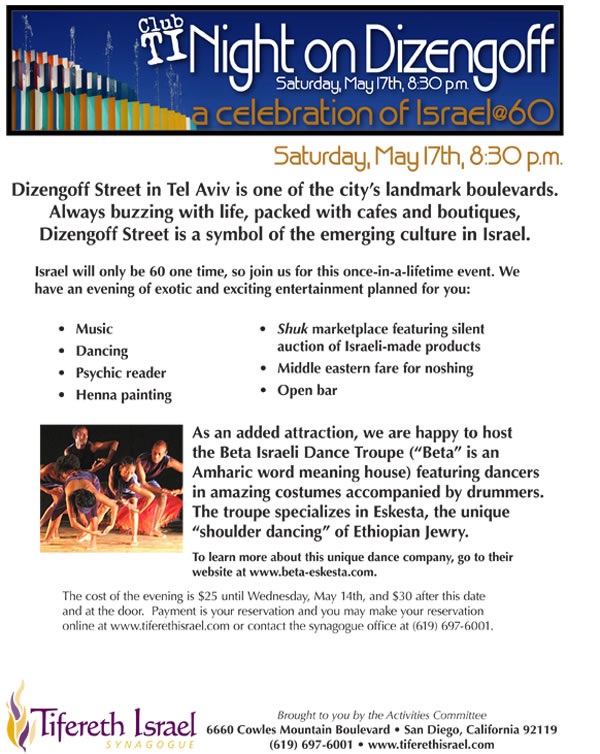

Sunday, May 18 Community Israel Independence Celebration

Wednesday, May 28 JFS~Ellen Saks lecture on mental illness
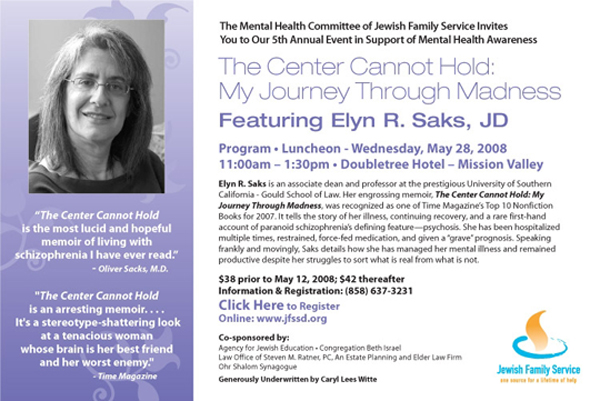

Tuesday, June 3 Guardians Golf & Tennis Tournament


Friday-Saturday, June 6-7 JFS~Judaism on the Wild Side

Sunday, June 8 Temple Solel~Tikkun Leil Shavuot


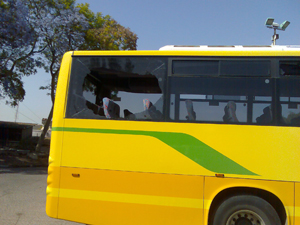 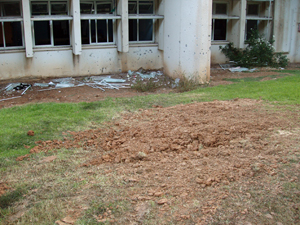
. {}
FROM THE GATES OF THE NEGEV
The daily hell on Israel's side of Gaza line
By Ulla Hadar
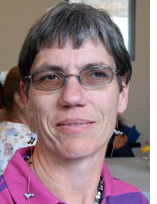 KIBBUTZ RUHAMA, Israel – As Israel celebrates its 60th anniversary with fireworks, the rockets that continue to burst over Sha’ar Hanegev, Sderot and other areas of the Western Negev are far more deadly. They are the mortars and Kassams fired by terrorists from Gaza. There have been several thousands of them over the last several years. KIBBUTZ RUHAMA, Israel – As Israel celebrates its 60th anniversary with fireworks, the rockets that continue to burst over Sha’ar Hanegev, Sderot and other areas of the Western Negev are far more deadly. They are the mortars and Kassams fired by terrorists from Gaza. There have been several thousands of them over the last several years.
The Sha'ar Hanegev municipality (comprising 10 kibbutzim and one moshav) face the border of Gaza and also are situated in a rough circle around the city of Sderot.
The mortars have a very short range and, for the most part, have hit Kibbutz Nahal Oz, although
Kibbutz Kfar Aza and other settlements close to the border fence also suffer mortar attacs. On Friday, May 9, Jimmy Kaddoshim, 48, of Kibbutz Kfar Aza was killed by a direct mortar attack when working in his garden.
The "Red alert" system that warns residents of incoming Kassams cannot identify the mortars and therefore there are no prior warnings to the population of a mortar attack.
The range of a Kassam rocket is between seven and nine kilometers (4-5.5 miles). This range makes potential targets of almost all the Sha'ar Hanegev settlements , including the schools, college, municipality, Yahadav Senior Center and the San Diego— Ibim Student village, to potential targets.
Kibbutz Ruhama is the only settlement out of range because of its position further inland.
Various settlements are at higher risk than others, because of their geographical positions: Kibbutz Gevim, Kibbutz Nir Am, Ibim Village, the school area and the municipality. The attacks on these settlements are almost daily and the settlements have suffered injuries and large material damage.
The settlements are connected to the "Red alert" alarm, and when a Kassam is activated from the Gaza strip, the population has only 15-20 seconds to run either to a shelter or another protected area or, if none of those are available, to lie down flat on the ground.
After the Kassam explodes, it is very dangerous to touch or to approach. First of all the rocket is extremely hot and second there might be some explosive left that didn’t detonate. According to the size and nature of the damages, different teams will promptly arrive at the scene—among them, fire brigades, ambulances, security officers and tax evaluators. The police demolition team, responsible for all the rockets, will arrive to remove the Kassams safely.
Most of the Kassam rockets thereafter are stored at the police station in Sderot. The rockets are all catalogued by date, size and place of the fall.
It is possible to recognize the terror organization that activated the Kassams by the following indications. The green Kassam rockets belong to the Hamas terror organization; the shorter and thicker rockets belong to the Islamic Jihad organization.
The only settlement with shelters and fortified rooms is Kibbutz Nahal Oz; all others have absolutely no protection against the rockets.
Recently Sha’ar Hanegev Mayor Alon Schuster, in cooperation with the local authorities, succeeded in getting the government's approval for financing the construction of fortified rooms for the rest of the settlements. The works will start with the more endangered areas of Kibbutz Nir Am, Kibbutz Gevim and the Ibim Student Village.
Throughout last year, buildings housing children under six years old have been provided with fortifications. The Elementary School is in the process of being rebuilt with fortification and is expected to be completed this year. As for the High School, there are plans to start building a new school this year. Funds are being raised in various ways, including by the upcoming “Walk The Land,” event planned at the Yom Ha’Atzma’ut Festival in San Diego this Sunday.
Lately, there have been attacks with a new kind of rocket called a Grad. This rocket has a longer range and stronger ammunition. This kind of rocket is able to reach Ashkelon.
To try to understand what the people living in the area has to deal with day in and day out, I am appending a letter written by Niva Hermoni-Meirovitch of Kibbutz Mefalsim. She was a recent participant in a “Professionals Exchange” that brought communal workers from Sha’ar Hanegev on a visit to the United Jewish Federation of San Diego County and related agencies.

By Niva Hermoni-Meriovitch
"Welcome to Kassam Land,” I answered my friend from Tel-Aviv, who came for a visit, while driving through Sderot. We were on the way to the JCC in Ibim, on a sunny, peaceful Saturday morning.
I was born in Kibbutz Mefalsim in 1964. I grew up there and went to school in Sha'ar Hanegev. I received my B.A. from the Sapir College where I have worked for the past 10 years. I built my house in Kibbutz Mefalsim and have 3 lovely children. Sha'ar Hanegev is my life.
A few days later, a terrible Wednesday afternoon at the Sapir College, a Kassam rocket fell and killed Roni Ichia, a student—may he rest in peace. The rocket fell in the staff parking lot where my car is parked every day, exactly in that spot. Just a few minutes earlier I had left there. I just could not stay around any more. The car that was parked next to mine was damaged and was declared a total loss.
Wednesday at noon. RED ALERT…BOOM…RED ALERT, RED ALERT…BOOM, BOOM…enough!!!
At about 3 p.m., my 7-year-old daughter had just finished her swimming training in the Hydrotherapy Center. She was waiting for the bus to take her home, away from there. The Kassams kept falling one after the other. All I could think about was, ‘please, leave, get away from there!’
The next day, on the way back home from school, a Kassam fell near the school. We were lucky again. Just a little bit more anxiety, a supplement to our "strength.” What is going to happen next? Are we waiting for something worse? How many more "booms" can we and our children absorb in our bleeding hearts?
That same week on Thursday we were on our way to Eilat for a preplanned vacation. On the way, a student from Sapir College talked on Kol Hanegev Radio about her feelings towards Sapir College, Sderot and the area. This is when I collapsed emotionally.
All the events from the previous day bursted out. I kept it so quiet that the kids would not hear, would not see. I did not want to add any more to their anxieties.
Sha’ar Hanegev is home. Kibbutz Mefalsim is home. Sapir College is home. So, you tell me why I cannot live in peace in my own home? Why do my children have to get exposed to these horrors? How much more “strength” will it take from us? What is this word anyway? Is it just some phrase that has been invented for us to show everybody how strong we are? What king of quality of life do we have here? We have long forgotten what that word means.
It is true that we get reductions in taxes. We are being invited to vacations, shows and theatre. The children are getting lots of candy for Purim. Thank you, to all of you that you are thinking about us. We would rather give it all up and have our quality of life back. We want our peaceful and quiet life back as it was 7 years ago, before my daughter was born. As the song says: "they say it was happy here before I was born…"
Happy – I cannot tell.
Quiet – without doubt it is not!

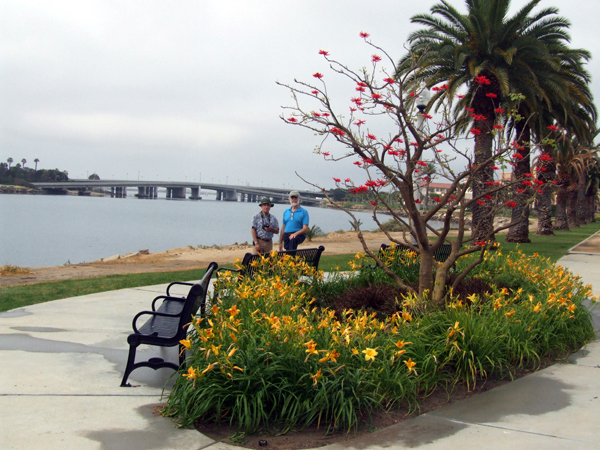
THE JEWISH CITIZEN
Walk through 4 centuries of S.D. history
By Donald H. Harrison
SAN DIEGO—In the space of an hour or two on Thursday, I strolled through four chronologically jumbled centuries of San Diego history with friends Dan Schaffer and Ron Reff . As the weather was San Diego true and we all had cameras, we were not in a hurry to get anywhere. It was a blessing just to savor the sites along San Diego Bay and its Boat Channel
The 18th Century was represented by Spanish Landing, the charming park across Harbor Drive from San Diego’s International Airport at Lindbergh Field. In 1769 Spanish colonists led by Capt. Gaspar de Portola and Father Junipero Serra met two ships of their expedition, San Antonio and San Carlos. Portola and Serra had come by land, so the rendezvous between their followers and the sailors aboard the ships was, at least at first, a joyous occasion. However, some of the sailors had sickened and died from scurvy during their long voyage.
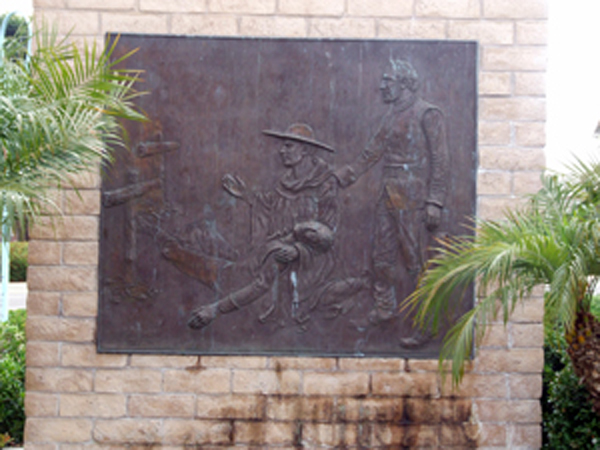
Near a bas-relief of a priest (Serra?) ministering to a dying man as a soldier (Portola?) touches his shoulder in sympathy is a plaque set into the ground, cemetery-style, which informs:
“Dedicated to the historic Spaniards who gave their lives and were buried near this site in 1769-1770 after accompanying Gaspar de Portola, the first governor of California, in the exploration of California from San Diego to San Francisco.”
The sculpture depicts two crosses in testimony to the religious history of our San Diego County—and this will perhaps be an important precedent when sculptures and a story board someday are placed at the site along our walk that best depicts San Diego’s 19th Century history, Louis Rose Point.
Currently, there are only benches and pretty landscaping at the Point named by the City Parks and Recreation Commission in honor of Louis Rose, who in 1850 became San Diego’s first Jewish settler. He went on to serve as president of the city Board of Trustees, chairman of the county Board of Supervisors, and as an entrepreneur with a wide variety of businesses.
Rose believed that Old Town, below Presidio Hill, was not the ideal location for a city, notwithstanding the fact that the same Spanish colonists whose exploits are celebrated at Spanish Landing decided to begin San Diego at the Presidio. The Spaniards had three reasons for the locations they chose: Presidio Hill was high, so it could be defended. It was near the San Diego River, so there was fresh water. And two villages of the Kumeyaay people were nearby—in areas that are today known as Misison Valley and Mission Hills. As converting indigenous people to Catholicism was an important goal for the Spaniards, the presence of the villages there was a key factor in where to locate the area’s headquarters fort.
The drawback was that Presidio Hill was several miles from the shore of San Diego Bay, from which during the middle 19th century, sailors waded to ships in order to carry passengers on their shoulders back to dry land.
Rose, who grew up in Neuhaus-en-der-Oste in the German state of Hanover, knew how important having businesses near shipping could be to the commercial development of a city. Neuhaus was situated on the mighty Elbe River, on which hundreds of ships a day sailed between the North Sea and the wealthy river port of Hamburg.
Gradually assembling sufficient land, Rose in 1869 established the town site of Roseville, where he hoped San Diegans would establish their homes and businesses and marry their fate to the bay. The city’s residents heeded his message about the importance of the bay, but most of them settled in a development that had been established along another part of the bay by rival developer Alonzo Horton. He created what is today’s downtown in San Diego. Roseville subsequently was incorporated into the community of Point Loma, where Louis Rose Point is located.
It is the hope of the Louis Rose Society for the Preservation of Jewish History—on which board I serve—to have erected at Louis Rose Point some statues and a story board depicting a vignette from Rose’s life. The businessman was quite fond of animals and kept his own menagerie out at Rose Canyon, where he had one of his homes. One of his pets was a large Galapagos Tortoise named Chili; another pet a small dog, Pat, who would take cover under Chili whenever it sensed danger. The Louis Rose Society envisions a grouping of Rose the entrepreneur, Chili and Pat, with the animals built of durable materials which children can climb upon and hug, thereby interacting with San Diego Jewish history.
Whereas people from other groups in San Diego history are represented by public sculptures, no member of the Jewish community ever has been so honored. We believe Rose is worthy of such recognition at Louis Rose Point. Tax-deductible contributions for the Louis Rose sculpture project may be made by writing a check to the Jewish Community Foundation/ Louis Rose Fund, 4950 Murphy Canyon Road, San Diego, CA 92123.
A short stroll from Louis Rose Point, along the manicured walkways of Liberty Station—known formerly as the Naval Training Center (NTC)—is a wonderful, impressive representation of life in San Diego in the 20th Century: The USS Recruit.
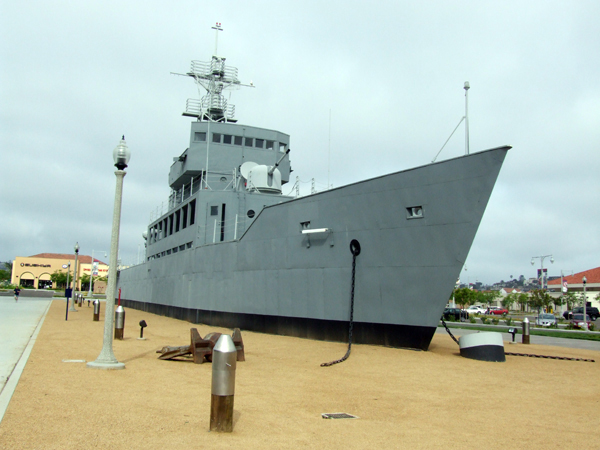
The ship is California Historical Landmark 1042. The legend on a marker near the ship tells its story:
“This two-thirds scale model of a destroyer-escort (TDE-1) helped instruct as many as 50,000 naval recruits annually in basic naval procedure. Commissioned 27 July 19949, the Recruit was the Navy’s only commissioned ship never to reach water. The Recruit was the first of three similar structures built by the Navy following World War II. It is the sole survivors of the three. Decommissioned 7 March 1967 when it could not be classified in a computerized naval inventory, the USSS Recruit nevertheless continued to train recruits and was recommissioned in 1982 as training guided missile frigate. Recruits gave the structure its affectionate nickname USS Neversail.”
From the ship-in-concrete, one may proceed over the Nimitz Bridge, a pedestrian bridge, across the Boat Channel to a walkway leading to Spanish Landing.
At Spanish Landing is also an important representation of 21st Century San Diego, where biomedical research has taken its place alongside the defense industry, tourism, agriculture and high tech communications companies as an important component of the area’s economy.
On the eastern end of Spanish Landing is Cancer Survivors Park, donated to the city by Richard and Annette Bloch of Kansas City. If you don’t recognize the names of this Jewish couple, think of Richard as the “R” in the tax preparation firm of H&R Block. He and his brother Henry changed the name of the company from Bloch to Block to avoid problems of pronunciation.
Although he was diagnosed with supposedly incurable lung cancer in 1978, Richard survived to 2004, when he was 78. Wanting to share the lessons he learned, the Richard and Annette Bloch Foundation decided to erect permanent, beautiful and hopeful installations in cities where the leadership wanted to help their citizens fight the scourge of cancer.
San Diego’s Cancer Survivors Park is similar to parks in other cities, with many of the same elements. Curving walkways lead to a domed plaza and past a set of sculptures, “Cancer: There is Hope” by Victor Salmones in which grim-faced cancer patients walk toward a maze representing their treatment regimens. Smiling-faced figures—at least when they are there; they could not be seen yesterday—emerge from the maze indicative of their successful treatment.
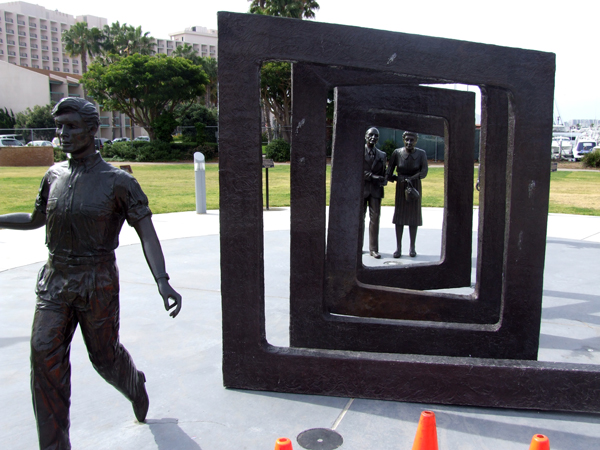
Along the “Positive Mental Attitude Walk” are messages summarizing some of the lessons that the Blochs learned.
Some of these are:
• Cancer is the most curable of all chronic diseases
• There are treatments for every type of cancer.
• Some people have been cured from every type of cancer.
• There are eight million living Americans who have been diagnosed with cancer. Three million are considered cured.
• Realize that cancer is a life-threatening disease but some beat it. Make up your mind that you will be one of those who do.
• Make a commitment to do everything in your power to help yourself fight the disease.
Near the sculptured figures is a plaque with a summary statement that bears reprinting:
“Fighting cancer is not a simple matter of thinking positively, wishing it away and saying ‘hey doc, cure me.’ It is a matter of knowledge. It is a matter of educating yourself about every detail and mustering all your resources. Use every drop of energy in an organized fashion to constructively concentrate on getting rid of cancer. Most cancers can be successfully treated but generally you have only one chance. If you miss that first chance, if you don’t do everything in your power, often there is no second chance. This is why no cancer patient can afford the luxury of looking back and saying, ‘I wish I would have.’ Never look back, concentrate on this moment forward and do everything in your power. There is no downside risk ; now you may have a choice.”
There probably is not a family in America today who does not have a relative or friend who fought or is fighting cancer. Certainly I did; my mother, Alice, survived breast cancer by 30 years. Even after cancer reemerged later in her life, she lived six years longer than some pessimistic doctors thought she would.
As we returned to Louis Rose Point, my thoughts were upon her. I am sure that my friends Dan and Ron found themselves in equally contemplative frames of mind. Robert and Annette Bloch and their family foundation made an important contribution not only to the beauty of San Diego, but to the health of its citizens.


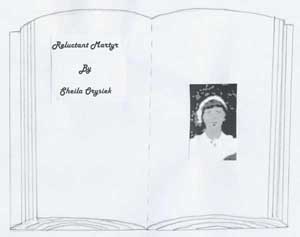 Editor's Note: This is the eighth chapter in our serialization of Reluctant Martyr, a historical novel by our columnist Sheila Orysiek. It is based on the experiences of her aunt. In each Friday-Saturday edition of San Diego Jewish World, we will run another installment of the 21-chapter book until its conclusion. We thank Sheila for granting us first publication rights to her book. Comments are welcome at sdheritage@cox.net Editor's Note: This is the eighth chapter in our serialization of Reluctant Martyr, a historical novel by our columnist Sheila Orysiek. It is based on the experiences of her aunt. In each Friday-Saturday edition of San Diego Jewish World, we will run another installment of the 21-chapter book until its conclusion. We thank Sheila for granting us first publication rights to her book. Comments are welcome at sdheritage@cox.net
Chapters 1 2 3 4 5 6 7 8 9 10 11 12 13 14 15 16 17 18 19 20 21
Reluctant Martyr—Chapter Eight
The sidewalks in the neighborhood were paved with dark brown bricks, not laid in straight lines, but at an angle so as to create an endless succession of “V’s.” And row after row, street after street, the houses stood, all very much alike with only occasionally a differently painted front door or an unusual curtain to make a distinguishing mark. But the people who lived in those houses seemed oblivious to the repetitive boredom of the view, nor would they have admitted to the sameness. There was little crime in the neighborhood, doors were seldom locked and people walked at all hours on the streets unafraid.
On warm days life was lived out of doors with the full range of emotion and activity on display. Children laughed and shouted in English, but behind the front doors their families spoke the tongue of the old country. So many were represented; next door to Hannah and Jahn’s house was a family from Latvia; across the street the Italians; the shoemaker was German; the very large family nearby were Irish. But, all considered themselves Americans, and proudly so. The day citizenship was acquired it was announced to everyone, up and down the street and in every shop. On the Fourth of July each door opened and as the resident spoke his native tongue, the flag went up on the door sill and the street became a symbol of a dream realized.
Etah was doing well in school; she had been enrolled in the first grade. No special attention was paid to immigrant children, they were expected to pick up the language on their own, and they did. After the first year Etah was skipped to the third grade in an effort to have her catch up with her age level. The family anxiously watched her progress and was adamant in their insistence that she pay close attention to her studies.
Sharona went every Wednesday evening to the benevolent association to continue her war with English. She mastered enough of it to eventually pass the test for citizenship, but she never felt comfortable carrying on a conversation in this language. Her native tongue was Yiddish and it was a language eminently suited to expressing the human condition in its many variegated tones. Etah went with her mother to these classes as much to keep her company as anything else but it also gave Hannah and Jahn an evening to themselves in their own house. For them this became a wonderful luxury.
On such evenings they did the things they enjoyed the most, reading, listening to music, having friends over. But, sometimes they simply sat together in the tiny parlor. The lion was still in full stride across the top of the bookcase, a clock ticked audibly on a table. The house was warmed by the coal furnace in the cellar, and outside perhaps it had snowed. Hannah enjoyed these evenings but there always lurked a terrible guilt within her. She felt slightly evil at looking forward to having her sister and mother out of the house, and so denied even this pleasure to herself. Hannah was never able to fully know happiness without searching her mind for a reason for guilt.
On Saturday mornings Sharona went faithfully to the synagogue on Girard Avenue. She did not consider herself a very religious person, certainly not in comparison to those who were orthodox in their observance. She believed in some moderation. She sat upstairs in the balcony with the other women and on hot days it was hotter there and on cold days much colder. The men participated in the service, the women observed. Sharona soon made friends with some of the women, many of whom were also immigrants from the same part of Russia. They were very much aware of the prominence of Sharona’s family and treated her with a formality they felt was her due. In spite of the vicissitudes through which life had led her, she still retained her beauty of face and bearing. And, she did not go unnoticed by the male members who sat below the balcony.
On one particular day, a rainy, chilly one at that, the house on State Street had a special visitor. A middle aged woman, known throughout the neighborhood for her keen interest in the affairs of others, made her way through the rain to call on Sharona. She ambled along, her umbrella flapping occasionally in a gust of wind, her kerchief tied snugly beneath her chin. Periodically she peered out from under the umbrella to check her progress. Large puddles were carefully avoided, but still her feet were wet, and she was much relieved when she arrived at the house. She climbed the two front steps and pressed the door buzzer.
It was mid-morning, Hannah was sitting at the dining room table writing a letter and Sharona was at the kitchen sink about to fillet a fish. When the buzzer sounded Hannah jumped up to go to the door. “Well, good morning, Mrs. Zunge, please to come in.” She took the woman’s umbrella and after shaking off the raindrops placed it in a bowl on the floor of the tiny front hall. “Let me have your coat.”
“Such weather we are having. I shouldn’t be out in such weather,” the woman muttered.
Sharona hastily stuffed the fish back into the icebox, and wiping her hands on her apron, she put a kettle on to boil. She came forward, “Maya, how nice to see you, there’ll be hot tea in a minute.” She pulled a chair out from the table. “Please sit down, Maya.”
Maya Zunge peered into the parlor, “Well, I see you have some new stuff, that sofa is nice, the pattern a bit loud, but nice. Nora says she gave it to you. Is that true? Things are so expensive these days. And, I see a new lamp, very nice. Did Nora give that to you too?”
“Here, Maya, the tea is ready, won’t you have some?” Hannah said, ignoring the questions. They all sat down in the dining room and sipped tea from glasses in typical Russian fashion, occasionally dropping in a cube of sugar.
“And where is Etah?” Maya asked.
“She’s in school, it’s a school day,” her mother answered
“Oh yes, yes, of course. And how is she doing in school? Nora says Joel is doing very well. So what is new on State Street?” She proceeded on, never waiting for a reply. “I hear the German shoemaker is not doing well. People are losing their jobs and they spend their pennies on food and don’t get their shoes fixed. And, the Irish family across the street, I hear he beats his wife. Is that true? Do you hear anything?”
“We don’t hear anything,” Hannah replied.
“So in this kind of weather,” Maya continued, “only important business would bring me out.”
“What kind of business?’ Sharona asked.
“But I forgot to tell you! Mr. Becker’s daughter is getting married. Yes! A very big wedding! Relatives are even coming from New York,” Maya paused to let that sink in. “He certainly can afford it. He makes enough money off of all of us in that grocery of his, I tell you! And the rabbi’s wife, did you hear what she said after Friday night services? But, that’s not why I came here.” Hannah and Sharona exchanged glances and waited patiently.
“Yesterday,” Maya went on, “I went to the sale at the fruit store. That man is such a cheat. It was no sale at all; the tomatoes were the same price as always! I would have told him too, but only that big son of his was there. But, wait till I see him! I’ll tell him that was no sale! Does he think I was born yesterday?” She paused the merest of moments, “This tea is very good. What kind is it?”
Hannah pulled the red and gold tin over, “It’s Swee-Touch-Nee.”
“I should have known; a good Russian tea.” Maya put her glass down. “Now let me also tell you, I hear that the fish store...”
Sharona interrupted her, “Maya did you say you came here on business?”
“Why, yes, of course!” Maya looked surprised. “I was sent here.”
“Sent? Who sent you?” Sharona asked.
“Someone very important.” Maya savored the moment. “I have a message, well actually a question. Those pearls are very nice, Hannah. Are those the ones Jahn gave you?”
“Is this business with me or Hannah?”
“Why, what else, with you, Sharona. Well, O.K. You know our rabbi?”
“Yes, of course, I know him,” Sharona answered.
“Well, it’s not him, it’s a bigger rabbi. The chief rabbi! You know he was married a long time ago to a very beautiful girl. She brought him a very large dowry, I heard. Anyway, the poor thing died giving birth. Both she and the baby died. By the way, that reminds me, do you see your son, Yarosh often? Are he and Sofia going to have any children?”
Sharona was growing a bit impatient. “What does the rabbi’s dead wife have to do with me?”
“The CHIEF Rabbi, Sharona, the CHIEF Rabbi, don’t forget,” corrected Maya. “All these years he’s lived alone, the lonely life of a widower. He likes you, Sharona. He’s thinking of marrying you.” There, she had said it.
Mother and daughter sat in stunned silence. “The chief rabbi of Philadelphia wants to marry me?” Sharona asked.
“Yes!” Maya was excited. “Now I know you are no longer young, and I’ve told him you probably have no dowry, nevertheless he asked me to ask you. Isn’t that wonderful? He has a big house and I hear.....”
“Are you sure, Maya, the chief rabbi wants to marry me?”
“How could I make up such a thing? I ask you! Would I come out in the rain if it weren't important?”
“When does he want an answer? Does he know I have Etah?”
“Yes, yes, of course he knows about Etah. I think he would like to know in about a week. I’ll come back in a week. Well, I’m going now, a lot of important things left to do.” She pushed away from the table. Hannah helped her on with her coat and handed her the umbrella.
“Be careful, Mrs. Zunge, the rain makes the steps slippery.” Hannah let her out the door and she walked off into the rain. Hannah came back to the dining room and the two women sat and looked at each other.
“The rabbi wants to marry me,” Sharona repeated softly.
“The CHIEF Rabbi,” Hannah said mimicking Maya and they both laughed. They sat and laughed until their eyes ran. When they had stopped Hannah asked her mother “What are you going to do?”
“I’ll think about it.”
It was a problem. The chief rabbi was a nice looking man and, of course, he was very well educated. Everyone in the community respected him and he did indeed have a big house. Sharona knew that the presence of both she and Etah in the very small home on State Street couldn’t help but rob her daughter and husband of their privacy and it was an added expense to feed two extra people. Hannah, she knew, loved having her, almost too much so. A young wife’s focus should be on her husband, Sharona thought, not so much on her mother. Hannah no longer ran the household as her own, but deferred to her mother. She also left most of the chores to her mother. And, then there was Etah. She was underfoot a lot and the jealousy between the sisters had not diminished.
Sharona was of all things a practical person and a marriage such as this could solve a lot of problems. On some days during that week she was ready to say “yes,” but a nagging reluctance remained. The rabbi, especially the chief rabbi, was an extremely religious man. Certainly he set a standard for the adherence to laws and traditions and his wife would be expected to be exemplary in this regard too. Sharona had never allowed herself to be so totally bound by religion; it could be a prison, especially for a woman. She knew she could never be happy in such an environment. But, on the other hand, she would no longer be a dependent widow and would have a house of her own, and Etah could have a better life too.
Maya Zunge saw to it that the neighborhood buzzed with the news. Everyone was impressed. When Sharona stepped out of the house, the neighbor from Latvia greeted her with unusual cordiality. Even the children of the large Irish family across the street turned to stare. When she and Hannah walked into the various shops on 40th Street, the hum of conversation lowered and everyone turned to look. The fruit store man brought forth his best tomatoes; after all, this could be the next wife of the chief rabbi. It was all so transparent, and yet to an extent, Sharona enjoyed it.
Around the supper table there was not much talk about the proposal. Jahn simply nodded his head when they told him and continued eating. Etah spooned more food onto her plate. On Friday night everyone gathered as usual for the Sabbath supper and Nora, of course, was bursting at the seams. She felt a marriage such as this would elevate her status in the neighborhood considerably. After all, she was related, wasn’t she?
The Sabbath prayer was recited and wine filled the silver cups Sharona had brought from the big beautiful house in Russia, guarded through all the flight and finally to safety in State Street. The supper dishes were cleared away and the usual tea and cookies served; the recipe for the cookies also came from the old country.
“Well, my dear sister-in-law,” Nora began, “this is quite some news I hear. You and the chief rabbi. You can have a lot of fun redoing that big house of his. Just think what a beautiful time you’ll have. Get married in the spring, Sharona, that’s such a nice time of year. How about April? Have you set a date?”
“No.” Sharona did not allow her annoyance to show in her voice or her face.
“Well, I’m sure he’ll go along with whatever date you chose,” Nora continued, “and you’ll need a big hall too. There will be so many guests. Have you made a list yet?”
“No.”
“My dear, you must start, you know these things take time. There’s so much to consider.”
“Nora, I have not yet given him my answer. It is two more days till the week is over.”
The men had gone into the parlor to listen to the news on the radio and Etah and Joel were sitting on the painted wooden floor playing a card game. Sharona and Hannah firmly kept the rest of the conversation off the subject of “the proposal.” It wasn’t easy. Nora really felt she should be the first to know. After all, she was related wasn’t she?
On the following Sunday morning it was quiet in the house. Jahn and Hannah had taken Etah to the zoo and Sharona found herself all alone which was a most unusual occurrence. She pulled a chair up to the bookcase, pulled down the door that opened to make a desk top and dipped her pen in ink. The creamy paper in front of her was blank and somehow she must fill it. Everyone expected her to give a verbal answer to Maya Zunge but Sharona knew that would be the same as shouting it from the rooftops, and this was a supremely personal matter.
Slowly the words formed themselves. She told him how honored she was by his proposal and she would honor it by giving it her sincerest consideration. She was very honest and told him that her commitment to religion and traditions was not nearly as deep as his, nor nearly as dedicated as it needed to be for the wife of a rabbi, a chief rabbi. She told him she did not feel she could be happy in such a role, and yet he deserved no less. And, so the answer was "no."
When Maya Zunge came to hear Sharona’s reply to the rabbi’s proposal, the neighborhood excitement was palpable. After the requisite tea and cookies, Sharona handed her the sealed letter and Maya’s stunned surprise and disappointment were plainly written on her face. She was incredulous.
“But your answer, Sharona?”
“It is in there. Give this letter to him.”
“In here?” Maya asked as she examined the seal.
“Yes.”
Maya left the house a broken woman; she positively wobbled down the street. She clutched with white knuckles the purse that held the letter. This, she thought, was unheard of.
Hannah was happy. Though she had felt it was an honor that her mother had been the object of a marriage proposal from the chief rabbi, she had dreaded any separation this might cause between them. Hannah wanted her mother as close to her as possible and it never occurred to her that Sharona might want a home of her own.
........................................
Jahn had rented a small room as his office. It was up a flight of stairs over a hardware store at the corner of 40th and Cambridge Streets, about three blocks from the house on State Street. A second hand desk, a chair and a light stand were the only pieces of furniture. The desk, a table with a drawer, had been placed near the window to take advantage of the daylight. It was always neat; a pen, inkstand, a few pencils and a sharpener were lined up on one side. Though he spent much of the day totaling long columns of figures, there was no adding machine of any kind; it was all done by head and hand. Each day he walked to the local shops with whom he did business and collected their account books and spent the rest of the day going through their piles of receipts. He filled the columns of the ledger books with his fine precise hand, both numbers and letters a pleasure to the eye. On his way home he delivered the account books to the shopkeepers, lingering awhile to exchange greetings.
From his window, Jahn could see much of the pulse beat of the neighborhood. Busy 40th Street was lined with the shops his wife frequented. Down the street Fairmount Park stretched green, away to the wider city beyond. When funds allowed, he purchased an old radio and listened to the classical music he loved so much as his hand sped over the columns of numbers.
As he sat by himself, dreams formed and multiplied. He dreamt of a house he and Hannah would own, not just rent, and for this he scrupulously saved a few dollars or more every week. Hannah knew they had savings, but she had no idea how faithfully he saved and that the amount was indeed growing. And, he dreamt of children. They had been married now two years and there were no children. He and Hannah never discussed it; he knew she would be terribly embarrassed to talk of such a thing. Certainly the family never spoke of it either and consulting a doctor was not even considered. It was a subject left in G-D’s hands.
At around noon Jahn opened the brown lunch bag Hannah had prepared for him and he spread out the sandwich and apple that were always the same. The little office had become an oasis and he enjoyed the quiet and the privacy. He finished the sandwich and took the apple with him to go for a walk to the bank to deposit his savings for the week. Upon reaching Girard Avenue he saw a knot of people about the bank along with two policemen on horseback and a couple more on foot. In front of the door stood a guard and no one was being admitted to the bank. Jahn immediately assumed that someone had been hurt or the bank had been robbed. But, it was worse than that, the bank had been closed and money that had been earned through such hard labor by the people in the neighborhood was gone. Where? The bank didn’t have it. Jahn stood there, as everyone else did, unwilling to believe this had happened.
The police asked the people on the sidewalk to leave and on his way back to the office Jahn bought a newspaper and it confirmed the terrible event. He sat in his chair, his spectacles on the desk in front of him, his face in his hands. The money was gone. The rest of the afternoon he forced himself to complete the day’s work, but by the time he walked home that evening a terrible sense of foreboding had settled upon him that this was only the beginning.
The house was bright when he opened the door, the lights were on and supper was ready. Hannah and Sharona were at the stove in the corner of the dining room, talking and laughing. Steam was rising from a bubbling kettle and the house was filled with the welcoming smell of cooking food. Etah sat at the corner of the table, her books spread out, as she did her homework.
After greeting them all, Jahn went up to the bathroom at the head of the narrow staircase. He washed his hands and face and peered into the wood framed mirror to see if his fears were visible and decided they were not. As he descended, supper was announced and Etah hurriedly put away her books on the sideboard that stood along the dining room wall. They all sat down at the table, but it was abnormally quiet. Somehow they sensed his mood and so he told them what had happened.
“The newspaper says the banks have lost our money,” he started. There were several moments of silence.
“How lost?” Hannah asked. “How can a bank just lose money?”
“I don’t know the details,” he replied, “but it’s gone.”
Hannah did not seem very upset. “Well, it doesn’t matter to us; we only had a few dollars there.”
“Hannah,” his voice was very low, “Hannah, there was more than you think, much more.”
She looked at him with great surprise. “How could that be?”
“I have been saving for a house,” he took off his spectacles and put them down on the table in front of him. “Every week I put some in.” A sob broke through his control as he covered his eyes with his hands. “There was a thousand dollars in there. It’s gone, it’s all gone.” Both Sharona and Hannah gasped and even Etah was very still. A thousand dollars was a princely sum, an amount not to be taken lightly.
Jahn got up from the table and went upstairs. Hannah did not follow, maybe he needed to be alone, she thought. Except for the time when Hannah had been saving for her family’s passage to America, she had never had to think about money and after marriage she considered it Jahn’s affair. The women of the society into which she had been born had no hand in the financial concerns of the family; that was considered the man’s sphere. It never occurred to her it might alter her life.
Only the child ate her supper, the adults ignored their food. The two women sat and talked in hushed tones about this strange happening. Etah finished her food, went into the parlor and turned on the radio. The news came on and they stopped talking to listen and they heard that it was indeed true, there was a run on some banks and some were being closed. Though they didn’t understand the economic issues involved, they knew something dreadful was beginning to happen to their beloved adopted country.
At first, except for the loss of the savings, their daily lives seemed unaffected. But, when Jahn stopped in at the fish market to get the money he was due, the merchant approached him sorrowfully. “Mr. Perris, I need to ask you a favor. I like your work, you keep my papers straight, but as you know I am barely making a living. I was hoping.... perhaps we can make a bargain here. Maybe I can pay you in fish?”
Jahn looked sympathetically at him. “I know my wife shops here so I don’t see why not. These times are starting to hurt a lot of people, I know.”
“Good. I’m glad we can agree. We’ll see how long this can go.”
“Good evening to you,” Jahn said as he left to go home and hoped Hannah wouldn’t mind.


ADVENTURES IN SAN DIEGO JEWISH HISTORY
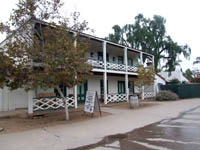
Robinson-Rose House
|
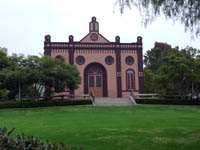
Old Temple Beth Israel |
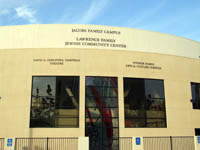
Lawrence Family JCC |
Editor's Note: We are reprinting news articles that the Southwestern Jewish Press ran in 1950. If you have historical topics about the San Diego Jewish community you would like us to explore, please e-mail your suggestions to editor Don Harrison at sdheritage@cox.net
Tifereth Israel Synagogue
From Southwestern Jewish Press, August 4, 1950, page 6
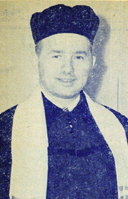 Congregation Tifereth Israel is happy to announce that Cantor Joseph Cysner {photo at right} has been engaged to officiate at the Congregation’s services. Congregation Tifereth Israel is happy to announce that Cantor Joseph Cysner {photo at right} has been engaged to officiate at the Congregation’s services.
Cantor Cysner is a graduate of the famous Cantor and Teacher Academy in Wurzburg. Since his graduation he has held positions as Musical Director in various European cities, he was Cantor and Musical Director of Temple Emil and official Cantor for the armed forces in Manila P.I. For the past four years Cantor Cysner has been a musical director in San Francisco. The Cantor, his wife and five months old daughter are making their home at 4428 Ohio St.
High Holidays—Seats for the High Holidays are being assigned by Ben Levinson, chairman of the seating committee, and his assistant Henry Bowman. Member of Tifereth Israel who have not sent in their cards should do so at once, so that seats may be assigned now.
Disunity is Not Our Aim: Open Letter to San Diego Jewry
From Southwestern Jewish Press, August 4, 1950, page 6
By Sol Goodman
President, Histadrut Council
It is with a deep conviction of a duty which must be done well and conscientiously that we, the Histadrut Council, announce the opening of the Histadrut Drive. However, we note with genuine concern that the President of the United Jewish Fund of our city has deemed it advisable to issue a letter in which we appear as extremely uncooperative citizens. We who stand on record as having cooperated loyally and unselfishly with the U.J.A. Drive, we who have the welfare and unity of San Diego Jewry as close to our hearts as any other group feel that we must take this opportunity of putting the facts before you.
Histadrut defined in technical terms is the Jewish Federation of Labor, but what is it really? It is the cooperative will of three fourths of the population of Israel, a will to pattern a new Jewish Society based on the highest Biblical precepts of mutual aid, cooperation, social equality and justice for all the people. Through the years, with their goals steadfastly before them, they transformed the malaria infested desert which was Palestine into that place we so proudly call Israel today. Financial returns were of no concern to them. Their investment was Idealism and hard labor—their return was much too often death from disease, hunger or unfriendly neighbors. But collectively their return was great, for through the years the thousands of collectives they established in Agriculture and Industry—the vast underground army, Hagana, they, the Histadrut organized ad trained—forged and established the State of Israel. Let it be understood, were it not for the pioneering Histadrut, we would have no State of Israel today.
The National Committee for Labor Palestine is asking a minimum of $10,000,000 for its National Histadrut Campaign. W, the Histadrut Council, who knows that this amount is a MUST, feel that we have to raise our appropriate share. We could not accept the local allotment for it is not commensurate with the needs of Histadrut. The Histadrut is not a direct recipient of the 83 percent which the U.S.A claims goes to Israel. Most of that money goes to the United Palestine Appeal, the Joint Distribution Committee, and the United Services for New Americans. True, they care for new arrivals, but, once the immigrants are in Israel the chief burden falls upon Histadrut as already pointed out.
Were the members of the allocation committee basically informed on the nature of the problem, we would undoubtedly have been able to compromise. But as no compromise was acceptable, we were duty bound to follow the lead of all other cities and initiate an independent Histadrut Campaign. We the Histadrut Council, including all the Labor Zionist Organizations, declare the month of August as Histadrut Month. Read our literature—feel with us the magnitude and scope of Histadrut’s pioneering work, and then, aid in our task. It is not only the size of the contribution which matters, but also the spirit in which it is given.
$3,000 Pledged at Initial Dinner
From Southwestern Jewish Press, August 4, 1950, page 8
San Diego’s first Histadrut Drive got off to an auspicious start at the Initial Gift Dinner held Sunday Evening, July 31st, at Tifereth Israel Synagogue. The dinner of Gefilte Fish, Blintzes and Borscht, prepared in the best tradition of Jewish culinary skill, preluded an inspiring evening to be remembered by the group of one hundred guests.
Mr. Cysner, an accomplished musician, and Tifereth Israel’s new Cantor, stirred the audience through his rendition of several Israeli songs with the gamut of moods which is Israel today—militant—tender—hopeful. The guest artist, Raasche, charming star of the Yiddish stage and screen, captivated everyone with her generous repertoire of English, Hebrew and Jewish folk songs.
Moshe Berman, one of Israel’s early pioneers, who has just returned from there, spoke intimately and eloquently of Israel’s heroic accomplishments, of her tasks ahead, and of Histadrut’s great historic goal past and present. He emphasized Histadrut’s tremendous task of transforming the masses of immigrants, composed of heterogenous cultures, many diseased, most of them disheartened and disillusioned, into healthy productive citizens. He stressed the fact that Israel must be ever prepared for a second round of war and that her boundaries must be fortified by numerous new colonies all along its borers and in the Negev. That too is pioneering Histadrut’s task.
The financial response was heart-warming and showed clearly that San Diego is determined to make its first Histadrut Drive a moral and financial success. A telegram, stating that San Diego raised $3,000 at its Initial Gift Dinner was sent to Histadrut in Israel.
Spearheading the drive are Rubin Umansky, Sol Goodman, Leo H. Brett, I. Domnitz, Dora Richland, Florence Barach and Eleanor Gordon.
{Return to top}
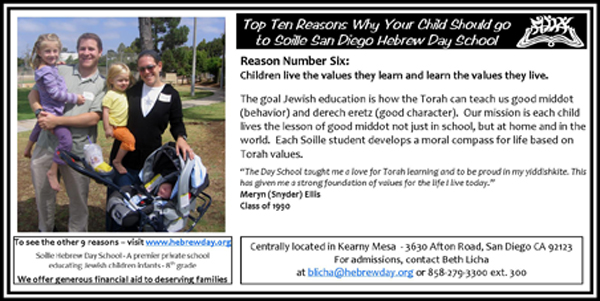

SAN DIEGO JEWISH WORLD THE WEEK IN REVIEW
Donald H. Harrison in San Diego: SDJA 10th grader breaks CIF seasonal strike out record, besting even David Wells' mark
Rabbi Dow Marmur in Toronto: Gay clergy issue prompts some Canadian congregations to leave United Synagogue
Hal Wingard in San Diego: His songs, "Sara," "Makhtesh Ramon," and "At the Jerusalem Wall"
Adventures in San Diego Jewish History: What was the Jewish community news in 1950? Who were the newsmakers? Our archives answer these questions in daily installments
Donald H. Harrison in Chula Vista, California: XLNC-1, TICO helping tore-popularize and internationalize classical music
Ira Sharkansky in Jerusalem: Intolerable situation on the Gaza border
Adventures in San Diego Jewish History: What was the Jewish community news in 1950? Who were the newsmakers? Our archives answer these questions in daily installments
Judy Lash Balint in Jerusalem: Pollard, Jewish identity and the drosh — subjects on a Jerusalem evening stroll
Donald H. Harrison is San Diego: Leftover matzah is no cocktail cracker
Sheila Orysiek in San Diego: City Ballet tilts and wins with Don Quixote
Fred Reiss in Winchester, California: Book examines biblical interpretations
Adventures in San Diego Jewish History: What was the Jewish community news in 1950? Who were the newsmakers? Our archives answer these questions in daily installments
Shoshana Bryen in Washington DC: Europe is fatigued by moral issues like the Holocaust, Israel's existence
Donald H. Harrison in San Diego: Chabad Jewish Center, St. Therese Catholic Church share history, but not theology
Sheila Orysiek in San Diego: A 'New Look' is something I don’t need
Gary Rotto in San Diego: Here's how consumers can help eliminate Americans' dependence on foreign oil
Eileen Wingard in San Diego: Felder portrays Beethoven the man and Beethoven the musician at Old Globe
Adventures in San Diego Jewish History: What was the Jewish community news in 1950? Who were the newsmakers? Our archives answer these questions in daily installments
Shoshana Bryen in Washington DC: Naqba, or catastrophe, is propaganda; truth is Palestinians' self-imposed victimhood
Ulla Hadar in Kibbutz Ruhama, Israel: Mortar kills Kfar Aza man in his garden
Donald H. Harrison in San Diego: Jewish-named places in San Diego's news
Rabbi Baruch Lederman in San Diego: The Rosh Yehsiva's love for his talmadim
Sigal Shalev Peres in Hazeva, Israel: A Yom Ha'atzma'ut party to remember
Rabbi Leonard Rosenthal in San Diego: Some guidelines for synagogue dress
Ira Sharkansky in Jerusalem: Olmert inquiry focuses on dealings with American fundraiser Moshe Talansky
Adventures in San Diego Jewish History: What was the Jewish community news in 1950? Who were the newsmakers? Our archives answer these questions in daily installments
< BACK TO TOP
|
|
